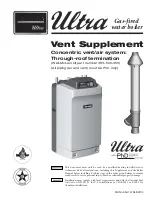
3
111241-01 - 3/21
WARNING
The following should be done on a continuous basis:
• Safe reliable operation of this boiler depends on proper periodic service by a qualified installer, service
agency or gas supplier.
• Proper air is essential for safe boiler operation. Do not block any fresh air opening.
• Keep area around boiler free of objects which are flammable or which could obstruct flow of air into
and around the boiler.
• Do not store or use sources of halogens such as bleaches, fabric softeners, paints, cleaners,
refrigerants and cat boxes near the boiler. Traces of these chemicals can be drawn into the boiler
causing severe corrosion damage to boiler and/or objectionable odors.
• Any damage caused by improper fuels, fuel additives or contaminated combustion air that may cause
fireside corrosion and/or clogging of burners or heat exchanger is not covered by the product warranty.
• Do not expose boiler to large amounts of dust such as generated by dry wall construction, fiberglass
insulation or woodworking.
1. A qualified installer, service agency or gas supplier must perform maintenance procedures shown in the
Installation, Operating, and Service Instructions on an
annual basis
.
2. Owner should visually inspect venting system on a
monthly basis
. If any of the following conditions are found,
the boiler should be shut down and a qualified installer, service agency or gas supplier called to correct the
problem before boiler is placed back in service:
• Loose joints, corrosion or other deterioration
• Condensate leakage
• Sags in horizontal runs of vent pipe
• (Chimney vent boilers only) Blocked vent switch not surely attached as shown in Figure 1 or 2, as
applicable
3. Owner should also perform a
monthly
visual inspection of boiler and surrounding system piping. To do this,
remove boiler jacket door. If any of the following are found, a qualified installer, service agency or gas supplier
should be consulted immediately:
• Deterioration of the visible controls, wiring, and sheet metal components
• Heating system water leaks
• Black carbon (“soot”) in or near the burner compartment area. See Figure 3 or 4
4. Steam Boilers – Steam boilers require
occasional
additions of makeup water to replace the small amount of
water lost through radiator and system vents. If an automatic water feeder is installed, this device should add
enough water on its own for boiler to operate. If there is no feeder and boiler needs more water, the red or yellow
"Low Water" light will be illuminated on the low water cut-off located on side of boiler. Wait at least 15 minutes
for all water in system to return to boiler and then open manual feed valve to add water. Stop adding water
when water level in gage glass reaches Boiler's Nominal Water Level (NWL). Consult Installation, Operating and
Service Instructions for NWL. Consult a qualified installer, service agency or gas supplier if you are not sure of
the location of the manual feed valve or cannot see the water level in the glass.
5. Auxiliary Controls – Many boilers are installed with equipment not supplied with the boiler, but which is critical for
safe, reliable operation of the boiler. Some examples of this type of equipment include zone controls and boiler
feed pumps. Make sure that this equipment is maintained in accordance with its manufacturer’s instructions.
Maintenance
WARNING
Black carbon (“soot”) in or near the burner compartment area is an indication of a potential carbon
monoxide hazard. If carbon is found, the boiler should be shut down immediately and inspected by
a qualified installer, service agency or gas supplier. The cause of the sooting should be found and
corrected before the boiler is restarted.
CAUTION
If it is necessary to either manually or automatically add water to a boiler more than once a month, a
qualified installer, service agency or gas supplier should inspect the system for leaks or defective vents.
Frequent additions of fresh water can result in severe damage to boiler.
!
!
!
























